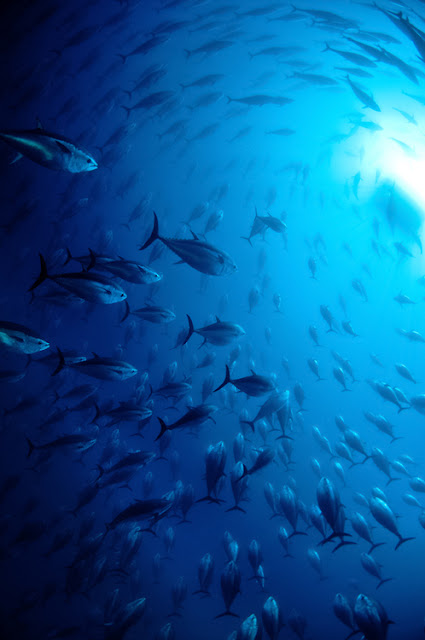" ScienceDaily (Mar. 15, 2012) — Giant and colossal squids have eyes as big as basketballs, and a Duke scientist thinks he knows why. "They're most likely using their huge eyes to spot and escape their predators, sperm whales," said Duke biologist Sonke Johnsen. "
Duke biologist Sonke Johnsen wanted to understand how and why
the giant and colossal squids use such a large eye.
He collaborated with a group of scientists, and the team discovered that the size and structure of the squid's eye allows it to see sperm whales approaching as they disturb bioluminescent organisms in the water.
"Big squids come in two types -- giant and colossal. They can grow to weights of five adult men put together, which is comparable to a large swordfish. But swordfish eyes are about the size of softballs, about 3 inches in diameter."
It was mathematics. The team measured the sizes of the giant and colossal squids' eyes. They collected data of the water clarity and the light penetration at the depths in which the squid live (300 to 1000 meters). Using the collected data, they mathematically modeled how the eyes would work and see at such depths and how they would function.
They found that the size of the squid's eye allows it to collect more light (think of nocturnal animals, such as owls and aye-ayes).
This ability to detect such light also aids the squid in detecting, very sensitively, changes in contrast' most importantly distant, far-moving objects, such as sperm whales. As their large cetacean predator approaches, it disturbs the biolumiescent organisms surrounding it, causing them to react. The squid's extra-large eye allows it to see the disturbance clearly and act accordingly.
The squids can sense this light-disturbance from 120 meters, or an entire American football field away.
However, the sperm whales echolocation, or sonar system, is far more effective. It would most likely sense the squid long before it sees the disturbance of light.
So then, why does the squid develop such an eye?
"...the squid's basketball-sized eye, and the body to carry it, isn't necessarily for moving out of the whale's detection range, but for planning a well-timed escape."
The theory is still being speculated, but it is certainly a difficult one to "falsify".
----------------








































